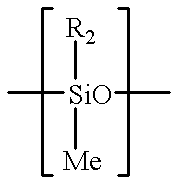Grafted rubber-like silicone gel with enhanced oil compatibility and its synthetic process
a silicone gel and fatty alcohol technology, applied in the direction of medical preparations, non-active ingredients of pharmaceutical products, toilet preparations, etc., can solve the problems of not being able to reduce the oily feel and appearance of skin, the composition of silicone gel disclosed by shakuzaki et al., and not being quite compatible with most cosmetic oils. to achieve good compatibility
- Summary
- Abstract
- Description
- Claims
- Application Information
AI Technical Summary
Benefits of technology
Problems solved by technology
Method used
Image
Examples
example 2
Petrolatum Silicone Gel
Charge a 50 gallon stainless steel reactor with 10.66 kg of methylhydro dimethyl siloxane copolymer having a molecular weight of about 4,000 and a molar content of methylhydro siloxane of 23.0% ; 2.56 kg of stearyl alcohol; 51.385 kg of cyclic polydimethyl siloxane and 0.022 kg of 2 wt % H.sub.2 PtCl.sub.6.6H.sub.2 O in isopropanol. Heat the reaction mixture to 130-140 and stir for about 3 hours until the stearyl alcohol is completely grafted on the methylhydro dimethyl siloxane copolymer as determined by HPLC. Add 79.165 kg of cyclic dimethylsiloxane and 29.831 kg of vinyl-terminal polysiloxane having a molecular weight of 9400. Stir thee reaction mixture at about 110.degree. C. for about 30 minutes until the mixture becomes extremely viscous or a soft gel. Add 6.381 kg of methyl hydrodimethyl polysiloxane having a molecular weight of 2000 and a methylhydro molar content of 15% and mix slowly until a firm rubber-like gel sets up. Change the mixer to a low spe...
example 3
Isoparaffin Silicone Gel
Prepare a rubber-like silicone gel according to Example 2. The isoparaffin silicone gel is prepared by premixing, by weight, 30 parts of the foregoing rubber-like silicone gel and 70 parts Of C.sub.12 -isoparaffin The mixture is then passed through a three-roll mill. The finished gel is clear and smooth and has a viscosity of about 70,000 cPs.
example 4
Bois Oil Silicone Gel
Prepare a rubberlike silicone gel according to Example 2. By weight, 35 parts of the rubberlike silicone gel, 21 parts of bois oil and 44 parts of a low viscosity silicone fluid are combined and mixed evenly. After the rubber is totally swelled, pass the mixture through a three-roll mill until a smpooth gel is produced. The resulting gel has a viscosity of about 70,000 cps.
These oil gels can be combined with commonly used inert and active materials such as protectives, adsorbents, pigments, demulcents, emnollients, astringents, antiperspirants, irritants, rubefacients, vesicants, cleansers, keratolytics, local anesthetics, and the like, to produce cosmetic and personal care products. Examples of such materials include, but are not limited to, aluminum magnesium silicate, benzocaine, black iron oxide, calcium carbonate, cellulose, coal tar, hydrocortisone, kaolin, magnesium carbonate, magnesium silicate, menthol, methylacrylate powder, mica, nylon powder, polyeth...
PUM
| Property | Measurement | Unit |
|---|---|---|
| Fraction | aaaaa | aaaaa |
| Time | aaaaa | aaaaa |
| Time | aaaaa | aaaaa |
Abstract
Description
Claims
Application Information
 Login to View More
Login to View More - R&D
- Intellectual Property
- Life Sciences
- Materials
- Tech Scout
- Unparalleled Data Quality
- Higher Quality Content
- 60% Fewer Hallucinations
Browse by: Latest US Patents, China's latest patents, Technical Efficacy Thesaurus, Application Domain, Technology Topic, Popular Technical Reports.
© 2025 PatSnap. All rights reserved.Legal|Privacy policy|Modern Slavery Act Transparency Statement|Sitemap|About US| Contact US: help@patsnap.com


